5 reasons for the failure of Thomas Cook, the world’s first travel agency
Table of Contents
Founded in 1845, Thomas Cook is the world’s first travel agency. A few years ago, the company was one of the world’s leading leisure travel providers operating in 17 countries, owning a fleet of aircraft and operating thousands of hotels around the world.
In 2019, the world watched its longest-running travel agency admit failure.
Let’s start from the beginning.
Thomas Cook – a short timeline
1845
Thomas Cook is an English businessman, who worked as a gardener and cabinet maker. He arranges for a party to travel from his hometown Leicester to Liverpool by train. Thus the world’s first travel agency is born. In 1846, he takes 350 people from Leicester on a tour of Scotland. A few years later he arranges for 150,000 people to travel to the Great Exhibition in London.
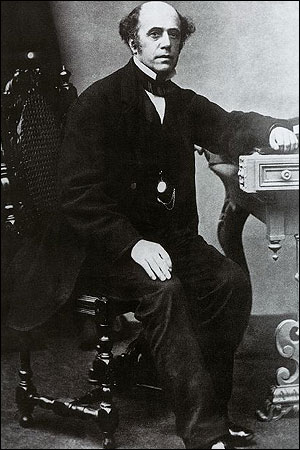
1855
In 1855, he plans his first continental tour, taking two groups on a grand tour of Belgium, Germany and France. The agency offers a complete package with its price including travel, accommodation and food, the first-ever of its kind.
1865-1866
The agency opens its first high-street shop in London. In 2019, the year of the collapse, the agency owns about 560 travel stores in the UK.
Thomas Cook’s son, John Mason personally conducts the company’s first American tour.
1872
Thomas Cook organizes the world’s first round-the-world tour. In the years to come, the company plans various tours to far-flung locations all over the world, including safaris in Africa. The company also expands into air and sea tours.
1965
The company’s net profits exceed £1 million for the first time.
1995
Launches thomascook.com, the first UK retail travel agency to offer customers a way to buy holidays online.
2000-2018
The company makes a series of acquisitions and mergers to extend its market share. The downside: acquiring a large debt.
2019
Royal Bank of Scotland, one of the company’s funders and a range of other banks demand that Thomas Cook Group PLC find $250 million in funding to ensure operations were protected.
The company’s management turned to the UK government for financial rescue. The UK government rejected its request.
Peter Fankhauser, Thomas Cook’s CEO, apologized to customers, employees, suppliers and partners and said the company “had no choice but to take steps to enter into compulsory liquidation with immediate effect” after talks on a financial rescue failed.” “This marks a deeply sad day for the company which pioneered package holidays and made travel possible for millions of people around the world.”
The group’s operations ceased immediately leaving around 600,000 tourists overseas including 150,000 British citizens.
It was the UK’s biggest peacetime repatriation.
Here’s another example: 4 reasons why fashion retailer Forever 21 went bust.
Thomas Cook – The scale of its collapse
Before entering into compulsory liquidation in 2019, here is an overview of Thomas Cook’s business:
- Thomas Cook Airlines owned a fleet of 93 aircrafts.
- The company employed approximately 21,000 staff worldwide, with 9,000 in the U.K.
- The agency offered its services in 17 countries either through its own branches or brand partners.
- Thomas Cook Group operated 3,170 hotels across 47 destinations.
- The group was the 2nd largest travel agency in Europe.
- Made EUR 9.5B in sales in 2018.
- Served 20 million customers every year.
- The company offered seven travel-related services: flights, hotel accommodation, cruises, foreign exchange, travel insurance, holiday packages, and one-stop shops, essentially meeting every need of its customers, from A to Z, with in-house resources.
Brand values: “Thomas Cook‘s promise to its customers is to be personal, trusted and innovative, placing them at the heart of everything it does.”
The downfall of Toys R Us – don’t blame Amazon!
5 reasons for Thomas Cook’s failure
- Late to change its business model;
- Failed to cut costs;
- Missed the opportunity to include Millennials among its customers;
- Didn’t come up with solutions to mitigate the consequences of Brexit;
- Acquired $2 billion in debt.
Late to change its business model
In 2017, Thomas Cook travel agents were still selling travel packages in high-street stores, while online sales in the UK were growing by as much as 30%.
The stores were in great locations and contributed to the company’s effort to maintain brand awareness. But the renting costs were high.
Thomas Cook began closing some of its physical stores and changed its strategy to an online platform. But it was too little too late and the online solution presented its own challenges apart from job losses which were significant. How to maintain online customer service at the same level as it was in physical stores when customers were talking to a person?
Failed to cut costs
In addition to cutting rental costs, the agency was struggling with the high costs of running an airline.
The airline industry is, in general, a highly competitive, low-profit margin industry. The customers are price sensitive and the internet environment allowed them to compare prices and go with the lowest. It is worth mentioning that most of Thomas Cook’s competitors did not operate flights directly.
Missed the opportunity to include the Millennials among its customers
With a new generation of travellers entering the market, the industry was bound to change. Millennials are different from their parents and their grandparents in terms of how they like to travel.
A 2016 survey revealed that Millennials would rather take more short trips – at least seven – throughout the year rather than one vacation package. That’s why city breaks became in high demand among this generation and the travel services providers had to adapt to this new way of travelling.
Also, Millennials behaved differently in that they planned their own itineraries, used digital tools (like Airbnb or Booking.com), focused on transformational experiences and were influenced by social media or user-generated content (source).
Thomas Cook failed to adapt to this new type of customer and as a result, its sales were going down.
Didn’t come up with solutions to mitigate the consequences of Brexit
The UK was set to leave the EU and that caused high levels of uncertainty and anxiety among the British people.
With neither the government nor the media shedding light on the issues at hand, the agency’s customers in the UK decided to postpone their holidays.
Brexit affected Thomas Cook negatively, especially since the agency didn’t come up with a solution to this situation.
Acquired large debt over the years
Over the years, following many acquisitions and mergers, the company acquired a $2 billion debt which it wasn’t able to solve.
The problems related to the company’s debt began to be relevant around 2010. The company’s growth was not possible without external financing.
Conclusion
In the span of 174 years, pioneer Thomas Cook had become one of the leading companies in the travel industry.
I believe two aspects of its collapse could have been prevented.
What happened was, as usually is the case with legacy brands, the company failed to adapt to technology and customer behaviour change.
In business, early adopters of the latest technologies turn the threat into an opportunity. Thomas Cook was a late adopter. Their customers shifted to online services before they did which resulted in the company losing the advantage and momentum. This is ironic, since Thomas Cook, the company’s founder started the agency by leveraging a new piece of technology which had just been introduced in the US, in the early 1800s: rail transportation. Read another example of a global brand that went bankrupt.
They also failed to keep a close eye on their customer’s buying behaviour and profile. A new generation was looking to travel, a new type of customer very much different from their customer base had entered the travel market and they were blind to the change. Customer behaviour analysis should be conducted periodically, not when sales are down. Understanding the psychological profile of our customers is essential.
Why Did Kodak Fail and What You Can Learn from its Demise
This is the second article in our Failure Stories series. Read our first article: Why did Nokia fail?

Kodak was founded in late 1880s, became a giant in the photography industry in the 1970s and filed for bankruptcy in 2012.
For almost a hundred years, Kodak was at the forefront of photography with dozens of innovations and inventions, making this art accessible to the consumer.
This article presents the reasons for Kodak’s demise and what every entrepreneur can learn from it.
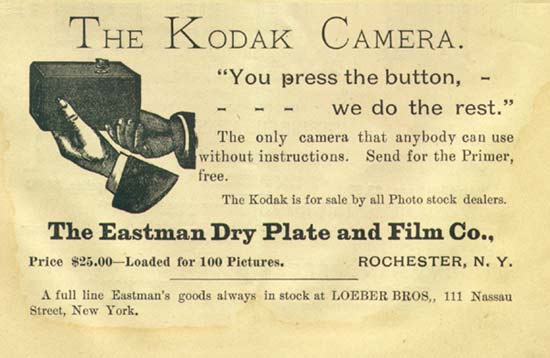
image source: wikipedia.com
Short Timeline of Kodak’s Landmarks
1889 – George Eastman founded the Eastman Kodak company and introduced the first Kodak camera; a few years later the Kodak camera becomes wildly successful.
1935 – The company introduced Kodachrome, the first successful colour materials and was used for both cinematography and still photography.
1962 – Kodak sales surpassed $1 billion.
1963 – The Kodak Instamatic cameras and cartridge loading films made the process easy for amateurs. The company sold 50 million Instamatic cameras in their first seven years.
1966 – Sales surpassed $2 billion.
1972 – Kodak’s worldwide sales passed $3 billion.
1975 – Steve Sasson, an engineer at Kodak invented the digital camera.
1976 – Kodak became so dominant, they practically pushed their competitors off the market –
Cameras: 85% market share, Film: 90% market share
1981 – Sales top $10 billion.
Late 1980s – The rise of the digital photography with analog cameras sales decreasing and digital camera sales increasing.
1984 – Customers switched from Kodak to Fuji because the Japanese colour film was 20% cheaper than Kodak’s.
1991- Kodak’s first digital camera.
1991-2011- Kodak released various digital products, but sales kept falling.
2012 – Kodak filed for bankruptcy.

image source: imperialleisure.com
Why was Kodak successful?
You press the button, we do the rest.
George Eastman
First of all, George Eastman set out to democratize photography.
Eastman believed in making photography available to everyone, by changing the way people took photographs. With the development of his new and innovative Kodak camera, Eastman made it possible for anyone interested in photography to take great pictures.
Throughout the following decades, innovations and inventions ensued which supported the company fulfil its founder’s purpose.
While Kodak’s offer met its clients’ needs, the business model of the Eastman Company brought in the cash. Kodak’s business strategy followed the razor and blades business model where one item is sold at a low price or given away for free in order to increase sales of a complementary good, such as consumable supplies.
How it worked: the clients would take photos with the Kodak camera and then send the camera to the Kodak factory where the camera’s film was developed, and photos were printed.
The company’s core product was the film and printing photos, not the camera. Kodak’s Kodachrome was the company’s leading sales item. It was discontinued in 2006 after 74 years of production.
The Industry’s Turning Point – Phase 1 – Photography Going Digital
When the digital came, the film sales went out the window.
In the 1980s, the photography industry was beginning to shift towards the digital. With Kodak inventing the digital camera, one would think that turning to digital would be the next logical thing for Kodak. The company jumped on the digital trend bandwagon – although it was a late adopter – while still selling analog cameras and film. Kodak developed a new business direction – printers. The company focused on the printing industry building expensive printers and inexpensive ink while its competitors were making money from selling expensive ink.
It seems Kodak had developed antibodies against anything that might compete with film.
Bill Lloyd, Kodak’s CTO via nytimes.com
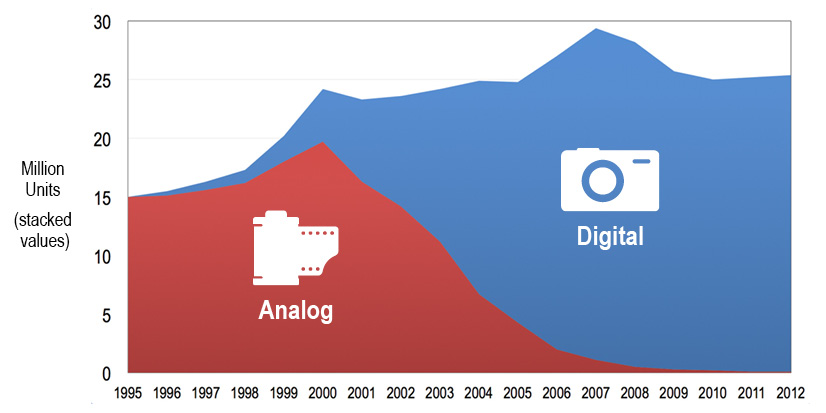
source: thirdway.org
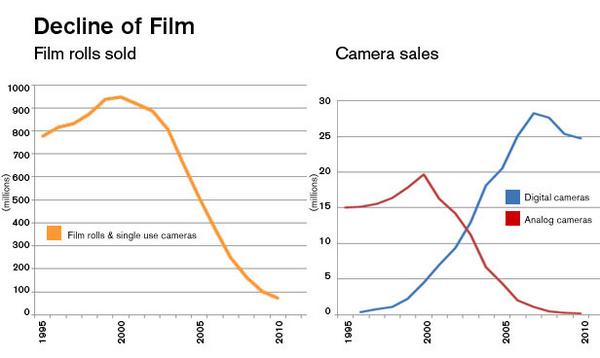
image source: Jake Nielson via Twitter
The Industry’s Turning Point – Phase 2 – Photography Going from Digital to Social
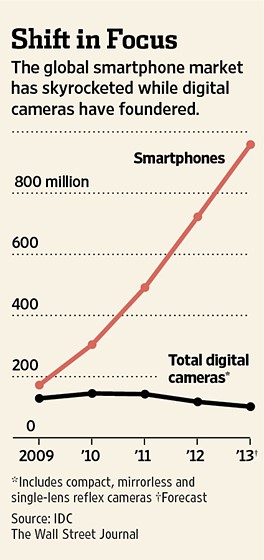
image source: dpreview.com
As it turned out, digital cameras were not the biggest fish in the pond. Smartphones took the world by storm and digital cameras producers saw their sales quickly spiralling down. People went from printing pictures to storing them on digital devices or sharing them online on social media platforms.
Many years before Facebook, Kodak made a surprise business move and acquired a photo sharing site called Ofoto in 2001. Unfortunately, instead of going the Instagram way, Kodak used Ofoto to try to get more people to print digital images.
In 2012, when Kodak was filing for bankruptcy, Facebook was acquiring Instagram, the new hot photo sharing social network for $1 billion.
Learn more: The Story of Instagram and WhatsApp Founders leaving their Facebook-acquired Companies
Kodak acted like a stereotypical change-resistant Japanese firm, while Fujifilm acted like a flexible American one.
Sharifah Khairin Syed Mohd Ali, in Kodak Strategic Blunder (SlideShare)
Here are 3 Reasons for Kodak’s Demise according to Analysts:
1. Failed to reinvent itself
Scott D. Anthony in Kodak’s Downfall Wasn’t About Technology:
The right lessons from Kodak are subtle. Companies often see the disruptive forces affecting their industry. They frequently divert sufficient resources to participate in emerging markets. Their failure is usually an inability to truly embrace the new business models the disruptive change opens up. Kodak created a digital camera, invested in the technology, and even understood that photos would be shared online. Where they failed was in realizing that online photo sharing was the new business, not just a way to expand the printing business.
2. Complacency
John Kotter in Barriers to Change: The Real Reason Behind the Kodak Downfall:
The organization overflowed with complacency. I saw it, maybe in the late 1980s. Kodak was failing to keep up even before the digital revolution when Fuji started doing a better job with the old technology, the roll-film business. With the complacency so rock-solid, and no one at the top even devoting their priorities toward turning that problem into a huge urgency around a huge opportunity, of course they went nowhere.
3. Lack of organisational agility
George Mendes – What Went Wrong at Eastman Kodak?
Kodak’s lack of strategic creativity led it to misinterpret the very line of work and type of industry that it was operating in which was later devastated with a fundamental shift towards the digital age. Strategic
problems were tackled through rigid means, and as mistakes in the manufacturing process were costly, and profitability was high, Kodak avoided risky decisions, and instead developed procedures and policies to maintain the quo.
Also
Furthermore, it was not only a case of delayed action, as although it was clear the business needed to get on to the digital bandwagon, Kodak’s executive staff were simply not prepared to take the necessary risks required in the form of a DRP.
What you can learn from Kodak’s demise:
- Transform the way you view strategy, business models and innovation management;
- Be prepared to shift from protecting your company’s competitive advantages to making change radical and revolutionary;
- To avoid complacency ensure that your innovators have a voice with enough volume to be heard (and listened to) at the top;
- Adopt agility as organisational strategy for development.
How to reframe failure: 6 steps
You failed.
There are various reasons why you failed.
Maybe your business lacked capital or you misused it.
Or you jumped the gun on essential steps in building your product and ended up with something that nobody wanted.
You didn’t communicate your vision clearly enough for everyone to understand and embrace.
You lacked resources. Or resourcefulness.
Maybe you chose the wrong business partner.
Maybe your people skills suck and you are too blind to see it. Remember: people do business with people they know, like, trust and value.
Think of your failure as a wound: weep bitter tears, care for it, wait for your wound to heal and move on.
Here is our list of 6 steps you can take to deal with your failure and reframe it:
1. take time to mourn
It hurts. Even if this wound is not physical, it hurts like hell.
Failure is highly emotional. Take your time to cry, stay in for a few days, TV binge-watching and eat a lot of chocolate or ice cream.
If you’re really angry, find a way to purge your anger in a positive way: don’t drown yourself in alcohol, go to the gym and sweat it out.
Don’t take it out on your friends and family, go punch a few bags at your local boxing centre.
2. even if you failed, YOU are not a failure
This is the most important thing you need to understand: failure is not a personality trait, it doesn’t define who you are.
This particular step helps you put a little emotional distance between you, as a person and failure as a result.
This is the aha moment that Oprah was speaking about. As soon as you realize it, the closer you are to healing your wound.
3. what, when or why
Remember when your mother applied antibacterial powder to your wound and breathed upon it to make it all better?
This is what you must do now: apply healing treatment.
Because you are now emotionally detached from your failure, you can see it as it is: a situation that needs analysis.
Together with your team or a close friend, analyze the problem at hand.
What happened, when did it happen and most importantly, why?
Be true to yourself and put your ego aside for the moment.
4. turn it into a learning experience
Now you know exactly what went wrong and why. You have a list of should’ve, would’ve, could’ve.
Take your bullet points and turn them into processes or checking lists or any other filters that can help you prevent further mistakes from happening.
5. don’t listen to what other people have to say about your failure
Don’t allow other people to put you down because you failed.
People that make other people feel bad about themselves speaks volumes about what kind of persons they are.
You don’t use salt to heal your wound, do you?
6. back in business
Failure is not falling down, but refusing to get up.
Chinese proverb
This is what it’s all about: everyone makes mistakes but only few are mentally strong to get back up and keep going.
What if Jack Ma gave up after failing twice with his early business companies? He wouldn’t have founded Alibaba, one of the most valuable technology companies in the world.
If you can not get used to failure — just like a boxer — if you can’t get used to [being] hit, how can you win?
Jack Ma
What if Steve Jobs gave up when he was fired from Apple, the same company he founded?
I didn’t see it then, but it turned out that getting fired from Apple was the best thing that could have ever happened to me. The heaviness of being successful was replaced by the lightness of being a beginner again, less sure about everything. It freed me to enter one of the most creative periods of my life.
Steve Jobs
What if Elon Musk gave up after so many of his rockets crashed?
Failure is an option here. If things are not failing, you are not innovating enough.
Elon Musk
Did you enjoy our article?
Share it with your friends!
The Role Accelerators Play For An Entrepreneurial Business

Nine out of ten startups fail. A statistic that sounds cruel and harsh, but that puts us with our feet on the ground. When one starts a business it does it with passion and hard work, investing all his/hers precious time and energy,with the hope to make it big or just simply make his /her dream come true or being on their own and share with the rest of the people a little bit of what makes them happy.
After deciding to take the leap and starting something of your own, one hardly thinks about giving up or about failure. Still, Gerard Adams from entrepreneur.com, points out that it’s almost impossible for people to create monumental success by themselves. “When we run blindly into business, thinking we can do everything on our own, without consulting with someone who’s been there before — it truly is a recipe for disaster. We’ve all been over-confident before, but the success of any empire is contingent upon the willingness to learn from the mistakes and achievements of others. It’s simply a fact that if you want to make a mark, it’s important to review the marks that have been made,” said Adams.
At this point in time mentorships, workshops and other business helpers are extremely important. An entrepreneur needs to learn from other people’s successes, but also from failures. And that, first hand, face-to-face. To be able to ask questions directly, as to the point as possible. “Startup accelerators and mentorship programs have grown in popularity as we’ve seen the huge upsurge of online entrepreneurship as well as the growth of service-based businesses and entrepreneurial ventures in general. In a 2013 survey by MicroMentor [a private business mentorship organization] mentored businesses increased their revenue by 83 percent. Those without mentorship only increased their revenue by 16 percent. This was over the course of a year,” explained further more Gerard Adams.
Accelerators are designed to prevent startups’ premature deaths. According to smallbiztrends.com, over the course of the last decade, the number of accelerators operating across the globe has skyrocketed. According to AngelList, a digital platform that helps to pair promising young startups with investors, there was only one American accelerator in operation in 2005. Today, there are 578, writes Scott Shane, professor of entrepreneurial studies at Case Western Reserve University and a regular contributor at Small Business Trends.
Accelerators are organizations that offer a range of support services and funding opportunities for startups. They tend to work by enrolling startups in months-long programs that offer mentorship, office space and supply chain resources. More importantly, business accelerator programs offer access to capital and investment in return for startup equity. “Startups essentially ‘graduate’ from their accelerator program after three or four months — which means that development projects are time-sensitive and very intensive. The primary reason accelerators have exploded in popularity is because they are designed to provide the best of both worlds for both startups as well as investors,” added smallbiztrends.com.
Susan Cohen of the University of Richmond and Yael Hochberg of Rice University highlight the four distinct factors that make accelerators unique: they are fixed-term, cohort-based, and mentorship-driven, and they culminate in a graduation or “demo day.” None of the other previously mentioned early-stage institutions — incubators, angel investors, or seed-stage venture capitalists — have these collective elements. Accelerators may share with these others the goal of cultivating early-stage startups, but it is clear that they are different, with distinctly different business models and incentive structures.
“I was able to identify 172 U.S.-based accelerators in existence during the 2005–2015 period. Collectively, they invested in more than 5,000 U.S. startups. During this period, these companies have raised a total of $19.5 billion in funding, a number that will surely increase as accelerator programs continue to turn out companies and recent graduates work their way to maturity. Accelerator graduates that went on to raise additional venture capital investment had a median valuation of $15.6 million during this period, and an average valuation of $90 million. Some very well-known companies belong to this group, including “unicorns” AirBnB, Dropbox, and Stripe, among others,” wrote Ian Hathaway for hbr.org.
How to use your past failure to push you forward in 2018
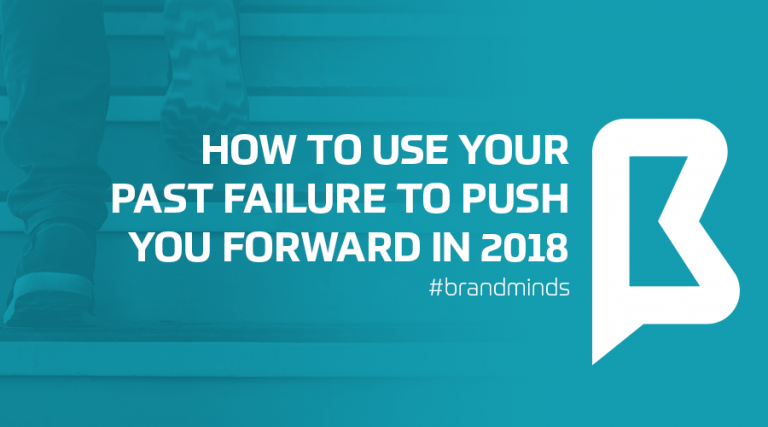
We are born afraid of failing. Always looking, checking and double checking to make sure we don’t fail. But the reality is that no matter what you do, at one time, at least,you will fail. The important thing is to know how to react when it happens, to be able to overcome the challenges and use them to our advantage.
“There’s a tremendous bias against taking risks. Everyone is trying to optimize their ass-covering,” said Elon Musk. And he is right, isn’t he? So get up, dust off and start thinking pro-actively. Each time you fall it’s time to get up and try again.
According to Grant Cardone for cnbc.com, the problem is that most people don’t know what to do when they fail. “The truly successful rely on their ability to act, despite facing obstacles and difficulties. When things aren’t going well, it’s easy to “take it easy” and to not be “hard on yourself,” like conventional wisdom tells you to do. To recover from failure, you have to act now and then keep going with the knowledge that enough actions taken will turn into the future you want,” wrote Cardone.
Here are some ideas of how you can cope with failure and move past it:
Understand that failure is just part of the process, accept it and process it
Like everything that happens, both at a personal and professional level, one must understand what happened, accept the situation, process it and then move on. Putting down the failure in writing is a good start, as well as steps you could have taken differently, positive things you learned from it, and what you’ll do if faced with it again. “Ask yourself what you have to do to become the name people think of for your area of expertise. This exercise will help you create the list of targets that will make your stretch goals a reality. Just because something didn’t work in the past doesn’t mean you should minimize your goals. It means that your actions were either wrong or not at massive, 10X levels,” added Grant Cardone.
Talk with somebody and let the frustration fly
Being to involved in the process and therefore too emotional about it can make you not see the details and the big picture. An expert eye as well as a couple of friends that work in different fields than you can help you get a different, fresh and good perspective on things. They might point out to you some aspects that, all of a sudden, seem very obvious and “in your face”.
Moreover, “once you have have taken some time to walk it off and clear your head, you can then begin accepting what happened. The initial emotional rush will eventually dissipate and you can then slowly return your focus back to the issue at hand,” pointed out Graham Young for fastcompany.com.
Innovate
“Working in business development, I am only as good as my latest plan to make money. Not every plan worked. This forced me to come up with more ideas at a faster pace. If one idea didn’t work, I was on to the next one. I had to shelve many ideas that I loved, but learning to “kill my darlings” only allowed me to birth new plans in a less precious way. Often, using what we’d learned from one thing failing makes the next iteration better and more successful,” wrote Victoria Cairl for entrepreneur.com.
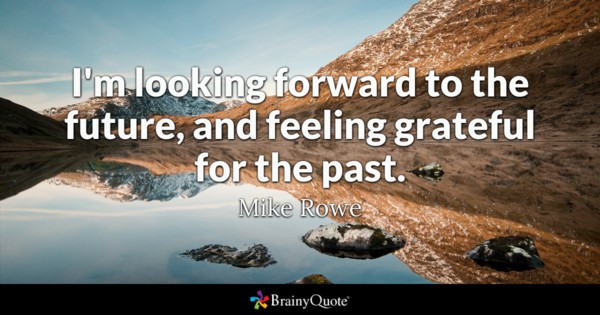
An honest feedback and perspective are the best
You shouldn’t be afraid of receiving the feedback you don’t want. Brutal honesty from your friends and experts, but also your own clear view, will go a long way. Don’t try and fix something that is unfixable or is not producing the right results. Letting it go and focusing on another idea or project, might just be the key. It would be much better for you to spend your time and dedication to an idea that shows real perspective and you know it can go further, rather than wasting energy on something that has no real value.
Don’t give up and be positive
Focusing on the negative will get you nowhere, while a positive thinking might do the trick. Moreover, don’t take a failure as a final try to your own business endeavor. Many of the successful people today have tries several businesses and ideas before hitting it big. “Generally, the more positive your attitude and outlook, the more that will permeate the rest of your actions and thoughts, creating a better experience going forward,” concluded inc.com.
Meet Joe Escobedo, One of Singapore’s Brand Minds
Recognized as one of the “Top 20 Content Marketers” worldwide and awarded the “Most Influential Global Marketing Leader” at the World Marketing Congress, Joe has helped countless organizations and executives transform from relative unknowns to superheroes online. He has also created and led successful digital marketing, branding and PR campaigns for both startups and Fortune 500 firms. He is a contributor for both Forbes and the HuffPost, as well as an award-winning speaker. His articles, interviews and talks have been read or heard by nearly one million people.
What is the significance of Joe Escobedo “The Brand Builder” and what is the story behind it?
“The Brand Builder” is a moniker given to me by my colleagues when we were trying to create ‘superhero’ names for the team.
You worked with companies from U.S., China and Singapore, which market did you like the most and why so?
The safe answer would be Singapore, but my five years in the gauntlet known as China made me what I am today. It taught me humility and the importance of guanxi (relationships).
Name one situation that made you want to quit and change your career.
I want to learn something everyday so there were times in my career where I felt like I wasn’t learning anything new or pushing myself hard enough. It’s during those times that I’ve transitioned to a completely new field or market. Sometimes I’ve failed miserably, but I learned from each experience and have grown from it.
Name one situation that made you want to go forward.
I’m driven when people tell me I can’t do something. I’ve been told that more times than I can count throughout my career. During those times, I think in my head, “hold on a second and watch this!”
What do you think are the most difficult challenges marketeers have to face in Asian markets nowadays?
Taking a long-term view. Too often, global headquarters look to the regional office in Asia and say, “You’re our growth engine now so you should be growing at a double-digit rate.” The problem with that is that it forces marketers to look only at the month ahead, rather than what’s going to rise up and disrupt their industry next year.
Investment matters. If you would invest in one particular business field nowadays. What would that be?
If I were looking for some quick cash, I’d say anything A.I. related. But I generally play the long game so I’d invest in things people always need, like food and toilet paper.
If you could change something about Singapore’s marketing community to improve it in any way what would that be?
I’d encourage the Community to take risks and invest more in digital. An ad plastered over the MRT may look great but what’s the return on your investment?
What made you settle down in Singapore?
The short answer: love. I followed my wife who received a job offer before I did.
Meet Joe Escobedo, The Man behind the suit
Name one good habit that helps you deal with your active life.
Reading to my daughter, because in that moment, I’m not Joe “The Brand Builder.” I’m whichever character I’m reading in the book.
Name one bad habit you can’t quit.
Speed walking. I tend to walk like I’m always 15 minutes late to a meeting.
If you could be anything else but a marketing leader, what would you be?
In another life, I would’ve been a film director. I wrote, directed and edited a sketch comedy movie when I was in college. I loved the experience and think I could’ve been a third-rate Christopher Nolan.
You are recognized as “One of the Most Influential Global Marketing Leaders”. What’s your favorite movie of a global marketing leader?
Don’t know if it’s about a global marketing leader per se, but Game of Thrones. After over a decade as a marketer, I see too many similarities between that show and the marketing world, albeit slightly less violent. For instances, strong alliances with the “right” groups can help you get closer to the corporate Iron Throne.
Tell us your favorite book. What’s the best thing you learned from it?
“How To Win Friends & Influence People,” by Dale Carnegie. I’ve read the book at least 10 times and everytime I ‘learn’ something new. My favorite lesson is about putting yourself in the other’s shoes – thinking about what they would want rather than what you’d want them to do.
Name the most important value you have.
Grit. It’s the only reason I’m still around and kickin’ in the professional world. Because even when I get battered to the ground, I claw my way back up. It’s an invaluable trait for any marketer or entrepreneur.
Name the most important value a leader should have.
Empathy. Every boss wants to make the most profit they can but they can only do so with a strong team behind them. And the only way to build and retain a strong team is to empathize with your staff’s situation. If they get demotivated because a client scolded them, then give them a pep talk. If there are unseen circumstances that caused them to miss a deadline then be understanding to their situation.
If you could compare your journey as an entrepreneur with a song, what song would you choose?
“Highway To Hell.” Just kidding! Instead of a song, my journey can be best described by “The Road Not Taken” by Robert Frost. From my move to China when I was 22, my career has been characterized by these lines: “Two roads diverged in a wood, and I— I took the one less traveled by, and that has made all the difference.”
Tell us the funniest experience you had this year related to your work.
Some of the funniest moments during the past year happen behind-the-scenes. For instance, we use to have “Happy Friday” dance parties at my company. And I’m not one to brag but my rendition of “Hotline Bling” by Drake stole the show.
If you would give our readers one advice from your professional experience, what would that advice be?
To quote the great Conan O’Brien, “If you work really hard, and you’re kind, amazing things will happen.” I truly believe that. Because everyone wants to help the hardworking nice guy or gal.
What is your biggest expectation for the Brand Minds ASIA event?
I’m looking forward to seeing Gary V walk on stage to a deafening cheer, unleash some savage knowledge and drop the mic.
Best Pieces of Advice For Women Entrepreneurs in 2017
According to fastcompany.com, women entrepreneurs are the fastest-growing segment of business owners in the U.S. But, compared to male-owned businesses, women-owned businesses generally fail at a higher rate, employ fewer people and generate less revenue. The reasons for the disparity are complicated and varied: difficulty in accessing capital, entrenched social norms, and differences in the industries male- and female-owned businesses tend to cluster are a few of the reasons behind the imbalance.
We are focusing on the positive and are determined to offer you some pieces of advice that we are sure will help you along the way.
Be bold. Be elegant.
One of the many advantages that women have other men in business is their ability to be bold and elegant, at the same time. Of having the courage to say what they think, openly, but beautifully. Their strengths, presented in a very elegant manner, makes them special and powerful. Likewise, loved by their employees.
Build for the high-expectation customer.
Here’s a common trap founders fall into: gain users at any cost. Often, they chase after daily active users, monthly active users and retention numbers. “They believe that appealing to every customer is one way of solving these problems,” says Julie Supan, who has counseled Airbnb, Dropbox and Thumbtack on branding. That’s the wrong approach, Supan cautions. Instead, focus on the high-expectation customer (HXC). She’s your ideal user, “the most discerning person within your target demographic. It’s someone who will acknowledge — and enjoy — your product or service for its greatest benefit,” Supan says. “If your product exceeds her expectations, it can meet everyone else’s.” The HXC serves as a valuable touchstone to ensure that you’re growing in the right direction and to validate — or invalidate — your action plan.
The deeper the context, the better the advice
Advice givers should always reframe questions to orient around the advice seeker, not their own expertise. And, after offering a spread of data points as context, advice seekers should always ask what they should do next.
Invest in people
Your employees are the best power you have after your own and the gem of your business. They will be the ones helping you achieve the success.

There is benefit to failure
Barbara Corcoran, the famous investor from the hit show Shark Tank once said “My best successes came on the heels of failures.” This is a powerful lesson for any aspiring business owner, as most of today’s most established entrepreneurs have been faced with countless failures. The importance of dealing with failure is that you need to be able to learn from the failure, dust yourself off and move on, even if you deal with consistent failure.
Never be afraid to follow your passion
Debbie Fields, the creator of Mrs. Fields, said “what I wanted was to be allowed to do the thing in the world I did best.” This motivated the entrepreneur to follow her passion for cooking, even when others didn’t believe it could turn into the success it is today.
You have to believe in what you are doing
Estee Lauder, founder of the famed makeup brand said “I have never worked a day in my life without selling. If I believe in something, I sell it, and I sell it hard.” Believing in the product and service that you are selling is the first and most important component of being a successful entrepreneur. Without a firm belief in what you are doing, you will never be able to find the success that you deserve, no matter how hard you work. You must believe in the company you have and work relentlessly to sell that idea to the world, making them believe in it as much as you do.
Big achievements are possible
Entrepreneur and iconic mogul Martha Stewart claimed that “it is within everyone’s grasp to be a CEO.” Years of gender bias have left some women not dreaming big enough with their professional aspirations. Stewart’s quote drives the point home in saying that everyone has the ability to earn this type of title, if they are willing to do the work. Dreaming big and visualizing yourself in a big role is one of the best ways to get started on a journey towards being a successful entrepreneur.
Taking risks is important
Lillian Vernon, founder of Lillian Vernon Corporation, once said: “I don’t look at risk the way other people do. When you’re an entrepreneur, you have to go in feeling like you’re going to be successful.” When Vernon started her company she was married and pregnant, and heard from so many people that starting her corporation was a risk, but it was one she was willing to take. Sometimes, a little risk has to be involved if you want to see the big payoff in the end.

Tell a visual story
Melanie Abrantes, designer, believes that the most important thing about selling your product online is to make sure that the images of your product are able to tell the full story. “Since people won’t be able to see it in person, they have to imagine what the product is going to look like in that setting. When you have professional photography involved, you are able to create a life for that product.”
The means don’t justify the end
The author and icon Gloria Steinem considers that the ends do not always justify the means, in business or in life. “In the end, the who you are is much more important than the what you are. And as beings who need social interaction to survive, the value in who you are while getting to where you’re going is everything. The means will always become the ends,” said Steinem, quoted by billboard.com.
Doubt is your biggest enemy
Trust in yourself and you will do just great. Don’t let anyone plant you doubts when your gusts it’s telling you something. Keep positive people around you that will influence you in a great way.
Celebrate every important step and victory
Make sure you embrace everything good that happens in your business. Don’t sell short your victories and try and enjoy each one of them. Success is not easy to come by and all your efforts and dedication deserve the party.
Keep in mind the big picture
Don’t get frustrated easily or become unhappy just because of some small step backs. Remember the big picture, what you want to accomplish, your main goals. They are the real deal.
More pieces of advice you may find here and here.
Failure is not the end
We are not used to talk about it, to consider it part of the process, to give it its big importance, to learn from it and understand that it might, or might not, take us to the success. What is sure ids that we mustn’t be afraid of it, try to hide it underneath the carpet and pretend like it never happened. The most successful people in the world lived through it, surpassed it and pushed through. Many entrepreneurs that we know and appreciate nowadays have failed with other previous business or fail daily in more or less important parts of their jobs or activities. Failure makes them stronger, teaches them the values and the importance of appreciating every step of the business track and, more than anything, the success, when and if it comes.
“We all have different definitions of failure, simply because we all have different benchmarks, values, and belief systems. A failure to one person might simply be a great learning experience for someone else. Many of us are afraid of failing, at least some of the time. But fear of failure (also called “atychiphobia”) is when we allow that fear to stop us doing the things that can move us forward to achieve our goals,” believes the team of www.mindtools.com.
The fear of failure may have various causes and goes back, most of the times, in our childhood, just like it happens with most of the things that define our lives and whom we are meant to be. Not having the right support, being undermined or humiliated in childhood, those are some causes that will most definitely carry negative feelings into adulthood.
As the editors of edutopia say, failure is an inevitable part of life, but it’s often accompanied by shame — most people do everything in their power to avoid it. As educational philosopher John Dewey said, a true thinker learns as much from failures as from successes. What if educators worked to take some of the sting (and the stigma) out of failing, and encouraged reflection and revision to build upon the lessons learned? “Perhaps there’s a goldmine of opportunities if we can re-frame failure as a valuable learning experience, an essential step along the path to discovery and innovation,” they added.
“Not talking about it is the worst thing you can do, as it means you’re not helping the rest of the organization learn from it,” said Jill Vialet, who runs the nonprofit Playworks. “It gives [the failure] a power and a weight that’s not only unnecessary, but damaging.” Vialet added, referring to the fact that the people involved in the failure should speak about it openly and work to prevent history from repeating itself.
This idea is already ingrained in the cultures of some for-profit industries. For example, in Silicon Valley, failure is a rite of passage. “If you’re not failing, you’re not considered to be innovating enough. Silicon Valley investors, in turn, regularly reward entrepreneurs’ risk-taking behavior, though they know the venture may fail and they will lose their capital,” it’s shown in an article on opinionator.com. In addition, Jill Vialet of Playworks emphasizes the importance of “failing fast and cheap” (as opposed to slow and expensive). She sets aside a budget for new programs that intentionally have unpredictable outcomes. They limit the scope of these programs, clearly define failure and success at the outset, and decide when to measure the new program’s merits. “It’s about being disciplined and rigorous,” said Vialet, since human nature normally prevents us from recognizing our mistakes while they are occurring, quoted by opinionator.com. A great article on the subject one also can find on guardian.com.
![]()
It all depends on how the organization and the people that run it see failure and its importance in business. Just as some organizations encourage employees to talk about failure in office events that are closed to the public, others publish their failures for the world to see. Engineers Without Borders Canada, which creates engineering solutions to international development problems, publishes a “ failure report” every year alongside its annual report. “I only let the best failures into the report,” said Ashley Good, its editor. The examples that are published, she said, show people who are “taking risks to be innovative.”
Moreover, Good also started a Web site, Admitting Failure, to encourage people working in international development to share their stories of failure. The site includes stories about arriving unprepared to an emergency medical situation in the Middle East, the theft of an expensive and underused water filter, and more.
In addition to nurturing a culture of innovation and reflection, talking about failure helps build a canon of knowledge of what not to do in the future.
Still, change doesn’t come over night and building a culture of openness to failure takes time and consistent effort. In the majority of cases, however, failure in the social change world does not involve as many dollars or stakeholders, and admitting it can have a net positive impact on an organization. Doing so can build institutional knowledge and create a culture where people are more open to taking risks.
Often, valuable insights come only after a failure. Accepting and learning from those insights is key to succeeding in life.
“The ability to grow and keep trying when you don’t succeed — resilience and grit — are key to cultivating a growth mindset, in academics and in life. I like how the business world has coined the term “failing forward” to mean using mistakes as stepping stones along the road towards achieving your goals”, says edutopia.org.
We can choose to see failure as “the end of the world,” or as proof of just how inadequate we are. Or, we can look at failure as the incredible learning experience that it often is. Every time we fail at something, we can choose to look for the lesson we’re meant to learn. These lessons are very important, they’re how we grow, and how we keep from making that same mistake again. Failures stop us only if we let them.
“Maybe failure doesn’t always lead to success but is simply the price of doing the right thing. Or sometimes tragedy strikes for no reason and without any apparent benefit. Maybe success in the broader sense comes in the form of failure itself when success’s definition is no longer limited to our individual lives,” says Anthony Sabarillo for medium.com
Instead of conclusion, we leave you with a very interesting article on lifehack.com, showing you six reasons it’s ok to fail.


